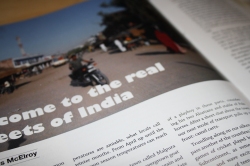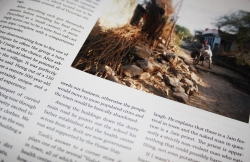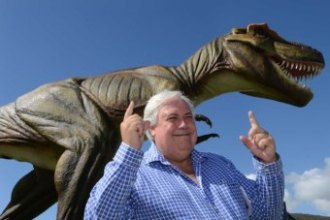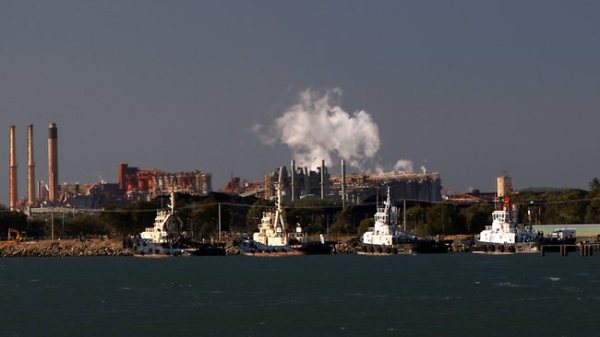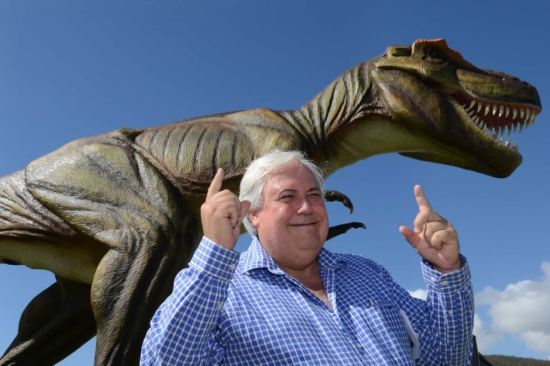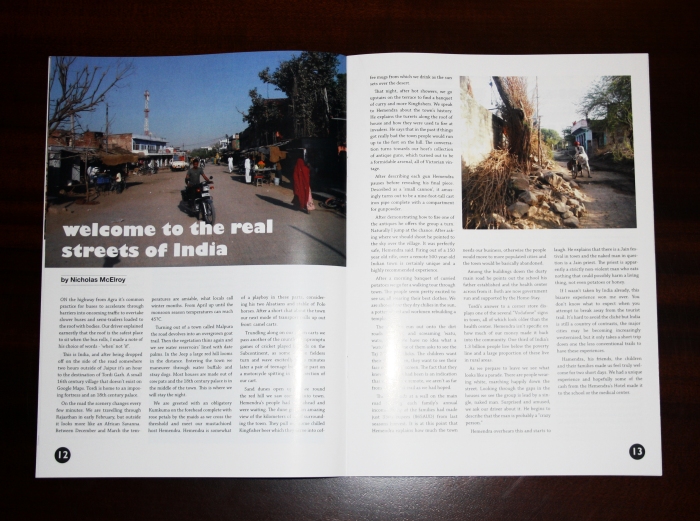 There’s no thrill like seeing your work in print. Above is a picture of the two page spread featured in Arbiter Magazine. Below is the text.
There’s no thrill like seeing your work in print. Above is a picture of the two page spread featured in Arbiter Magazine. Below is the text.
ON the highway from Agra it’s common practice for buses to accelerate through barriers into on coming traffic to overtake slower buses and semi-trailers loaded to the roof with bodies. Our driver explained earnestly that the roof is the safest place to sit when the bus rolls, I made a note of his choice of words – ‘when’ not ‘if’.
This is India, and after being dropped off on the side of the road somewhere two hours outside of Jaipur it’s an hour to the destination of Tordi Garh. A small 16th century village that doesn’t turn up on Google Maps. Tordi is home to an imposing fortress and an 18th century palace.
On the road the scenery changes every few minutes. We are travelling through Rajasthan in early February, but outside it looks more like an African Savanna. Between December and March the temperatures are amiable, what locals call winter months. From April up until the monsoon season temperatures can reach 45°C.
Turning out of a town called Malpura the road devolves into an overgrown goat trail. When the vegetation thins again and we see water reservoirs’ lined with date palms. In the Jeep a large red hill looms in the distance. Entering the town we maneuver through water buffalo and stray dogs. Most houses are made out of cow patties and the 18th century palace is in the middle of the town. This is where we will stay the night.
We are greeted with an obligatory Kumkuma on the forehead complete with rose petals by the maids as we cross the threshold and met our mustachioed host Hemendra, who is somewhat of a playboy in these parts considering his two Alsatians and stable of Polo horses. After a short chat about the town our next mode of transport pulls up out front: camel carts.
Trundling along on our silken carts we pass another of the countless impromptu games of cricket played by kids on the Subcontinent, some of the fielders turn and wave excitedly. Two minutes later a pair of teenage boys ride past on a motorcycle spitting in the direction of our cart.
Sand dunes open up as we round the red hill we saw coming into town. Hemendra’s people had run ahead and were waiting. The dune gave an amazing view of the kilometers of sand surrounding the town. They pulled out some chilled Kingfisher beer which they served into coffee mugs from which we drank as the sun set over the dessert.
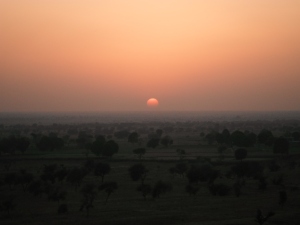
That night after hot showers we went upstairs on to the terrace to find a banquet of curry and more Kingfishers. We spoke to Hemendra about the town’s history. He explained the turrets along the roof of house and how they were used to fire at invaders. He said that in the past if things got really bad the town people would run up to the fort on the hill. The conversation then turned towards our host’s collection of antique guns, which turned out to be a formidable arsenal, all of Victorian vintage.
After describing each gun Hemendra paused before revealing his final piece, which he described as a ‘small cannon’, which amusingly turned out to be a nine-foot-tall cast iron pipe with a compartment for gunpowder.
After demonstrating how to fire one of the antiques he offered the group a turn. Naturally I jumped at the chance. After asking where we should shoot he pointed to the sky over the village. It was perfectly safe, Hemendra said. Firing out of a 150 year old rifle, over a remote 500-year-old Indian town is certainly unique and a highly recommended experience.
After a morning banquet of curried potatoes we went for a walking tour through town. The people seemed pretty exited to see us; they had on their best clothes. We were shown how they dried chilies in the sun, a pottery wheel and workmen rebuilding a temple.
The children ran out onto the dirt roads laughing and screaming ‘watu, watu, watu!’ We had no idea what a ‘watu’ was until one of them asked to see the Taj Mahal. It clicked. The children wanted their photo taken, they wanted to see their face on a digital screen. The fact that they knew where we had been was an indication that while we were remote, we weren’t as far from the tourist trail as we had hoped.
The tour ended at a wall on the main road tallying each family’s annual income. Many of the families had made just 3500 rupees ($65AUD) from last seasons harvest. It was at this point that Hemendra explained how much the town needed our business, otherwise the people would move to more populated cities and the town would be basically abandoned. Among the buildings down the dusty main road he pointed out the school his father established and the health center across from it. Both are now government run and supported by the Home-Stay.
Tordi’s answer to a corner store, which displayed one of the several ‘Vodafone’ signs in town all of which looked older than the health center, Hemendra wasn’t specific on how much of our money made it back into the community. One third of India’s 1.3 billion people live below the poverty line and a proportion of these people live in rural areas.
As we prepared to leave that afternoon we saw what looked like a parade. There were people wearing white, marching happily down the street. Looking through the gaps in the houses we saw the group was lead by a single, naked man. Surprised and amused we asked our driver about it, he began to describe that he was probably a ‘crazy person.’ Hemendra overhead this and started to laugh, he explained that there was a Jain festival in town and the naked man in question was a Jain priest. The priest was apparently a strictly non-violent man who ate nothing that could possibly harm a living thing, not even potatoes or honey.
If I wasn’t taken by India already, this bizarre experience won me over. You don’t know what to expect when you attempt to break away from the tourist trail. It’s hard to avoid the cliché but India is still a country of contrasts, the major cities may be becoming increasingly westernised, but it only takes a short trip down one the less conventional trails to have these experiences.
Hamendra, his friends, the children and their families made us feel truly welcome for two short days. We had a unique experience and hopefully some of the cash from the Hemendra’s Hotel made it to the school or the medical center.
